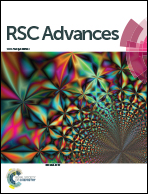Understanding the role of manganese valence in 4 V spinel cathodes for lithium-ion batteries: a systematic investigation†
Abstract
In order to understand the influence of manganese valence on electrochemical performance of spinel manganese oxide cathodes, a systematic investigation of doubly substituted LiMn2−x−yZnxTiyO4 (0.05 ≤ x ≤ 0.25, 0.05 ≤ y ≤ 0.2) spinel compositions has been reported. The synthesized substituted spinel oxides are correlated to the initial manganese valence, observed capacity, ratio of observed to theoretical capacity, capacity loss, degree of manganese dissolution, and irreversible capacity (IRC) loss. The capacity retention and initial observed capacity are found to depend on the manganese valence for the fixed amount of manganese content in the material. The obtained chemical and electrochemical data reveal that the extraction of lithium becomes more difficult with decreasing manganese valence. This phenomenon can be explained by the perturbation of the Mn–Mn interaction across the shared edges, which reduces the ability to extract lithium from spinel cathodes. These investigations lead to finding the optimum doped compositions that can offer the combination of long cycle life, high capacity, and high rate capability.


 Please wait while we load your content...
Please wait while we load your content...